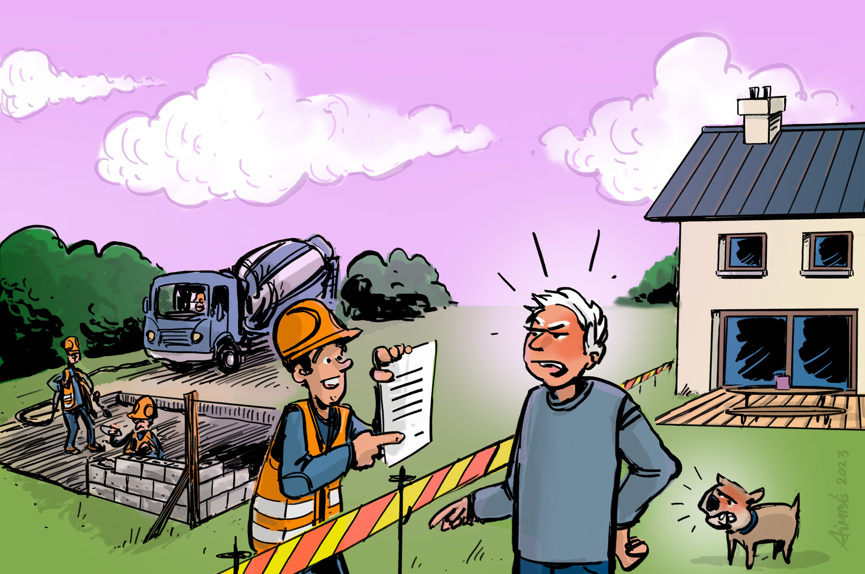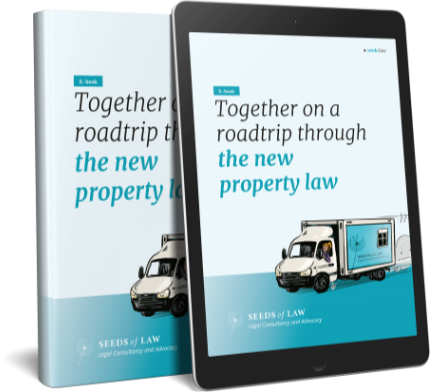- Real Estate, Renting and Co-ownership , Construction Law , Liability and Insurance
- neighbour , neighbour nuisance , building , renovation , property causing nuisance , attribute of ownership , person claiming the nuisance , property causing the nuisance , claim nuisance , contractor , architect , neighbourhood , preventive claim , serious and manifest risks of safety, health or pollution
Since 1 September 2021, the new property law has been in force and neighbour relations have been given a specific place in this law.
Koen de Puydt and Ulrike Beuselinck, in collaboration with LegalNews/LegalLearning, recorded a webinar concerning 15 practical questions relating to the impact of the rules on neighbour nuisance when building or renovating.
Before you all go into well-deserved holiday, Seeds of Law gives you some "facts and figures", that you, as a professional in the construction industry, may face when carrying out construction works. We do not aim to scare you, but rather to make you vigilant of potential problems that you can avoid with a good contract. We at Seeds of Law believe it is important to inform you proactively so that you can focus on what really matters to you, namely your activity and business.
However, if you still have questions after reading this article, you will find our contact details below. You can also watch the next webinar via the following link: https://legallearning.be/product/verbouwen-en-de-impact-van-de-regelgeving-inzake-burenhinder-15-praktijkvragen/.
We would also like to refer you to our e-book on the new property law entitled: "On a road trip through the new property law", which you can download by clicking this link.
So please do not hesitate to contact us to see how we can assist your company. After all, all the flowers of tomorrow are in the seeds of today.

Facts and figures nr 1: Did you know neighbour nuisance can occur even if you have not made a mistake?
While this was not always true in the distant past, neighbour nuisance has been labelled as faultless for the last 60 years. This means that you do not need to make a mistake to cause neighbour nuisance and be sued for it.
That neighbour nuisance does not require a fault is the premise of the new article on neighbour nuisance, but reading this article carefully, it does seem to contain a standard of conduct:
"Neighbouring owners each have a right to the use and the enjoyment of their real estate. In exercising their use and enjoyment, they shall respect the balance created, by not imposing on the neighbour any nuisance that exceeds the normal inconveniences of neighbourhoods and is imputable to him."
While neighbour nuisance does not require fault, the nuisance must nevertheless be the result of an act, omission or conduct. Therefore, for neighbour nuisance, there must be an act or omission attributable to you. You must therefore have done more than merely own the property (or have a personal or property right in rem) before you can be blamed for neighbour nuisance.
However, case law and legal doctrine will further elaborate on this and refine conditions and implementation.
Facts and figures nr 2: Did you know that even as a non-owner, you can be sued for neighbour nuisance?
Even if you are not the owner of the property causing nuisance, you can still be sued for neighbour nuisance.
The mere fact that you would possess a personal or real right, and therefore have an "attribute of ownership", is enough to be considered a neighbour and thus liable for neighbour nuisance.
An "attribute of ownership" refers to the rights in rem or personal rights one has over a property. In addition to the owner and co-owners, the following persons can therefore also be held liable for neighbour nuisance: the tenant, the usufructuary, the long lease right holder, the leaseholder, an occupier by way of begging, a concessionaire, a festival organiser, the electricity company that installs pipes in the public road, ....
In this case, the nuisance must come from the exercise of your part of the attribute of the ownership.
For example, if nuisance is caused by demolition works of an existing building, but you only have a right of superficies - which only becomes applicable at the start of the construction works - then you cannot be considered the "nuisance neighbour".
Conversely, it is also true that the person claiming the nuisance does not necessarily has to be the owner of the property causing the nuisance. Again, the possession of an "attribute of ownership" is sufficient for this person (e.g. a tenant, an occupier in lieu, a concessionaire) to claim nuisance.
Facts and figures nr 3: Did you know that as a contractor or architect, you generally cannot be sued for neighbour nuisance?
A contractor or an architect who carries out works on behalf of the owner, causing nuisance to the neighbouring property, is basically foreign to the legal ties arising from neighbourhood.
The architect or contractor can only be sued on the basis of non-contractual or civil liability.
In contrast, the owner-principal is liable for the nuisance caused by the architect or the contractor.
If some cases, the owner-principal and the contractor can be ordered in solidum.
However, the owner-principal and the contractor can agree on this in their mutual relationship. For example, the architect and the contractor can agree with the principal that either of them or both will indemnify the owner in full, even if they did not commit a fault. But, if the contractor or architect did commit a fault, then, whether or not an indemnification clause was agreed, the owner (or the holder of the attribute of the ownership) can also hold the contractor or architect call on them to indemnify, to the extent that that fault led to or increased the neighbour nuisance.
Facts and figures nr 4: Did you know that you can face a preventive claim (such as a cease and desist order) even if there is no nuisance or damage yet?
Neighbour nuisance could be invoked in case the nuisance actually takes place. For a long time, it was assumed that a mere potential nuisance was not sufficient.
The new law now expressly allows, under strict conditions, a preventive action, namely "If a property causes serious and manifest risks of safety, health or pollution in respect of a neighbouring property which breaks the balance between the properties, the owner or user of that neighbouring property may claim in court that preventive measures should be taken to prevent the risk from materialising."
To bring a preventive action, there must be:
- A serious and manifest risks of safety, health or pollution;
- In respect of a neighbouring property;
- which breaks the balance between the properties.
If the conditions are met, the owner/user of the neighbouring property can demand the courts to order measures to prevent that the risk materialises.
As a result, neighbours have the right to have your works stopped and/or measures imposed even before your construction works have caused nuisance or damages.
As this can have a serious impact on your obligations towards (sub)contractors and buyers (for example delay fines to pay), you should take this into account when drafting your contracts. Bear in mind that you can also make arrangements with your neighbours.
Fact and figures nr 5: Did you know that you can be sued by persons far beyond the neighbouring property?
Neighbourhood does not require that the properties are adjacent, only that they are sufficiently close so that the event on one property could have an impact on the other property.
Therefore, even a plot located hundreds of meters away claiming to be affected by your works can claim you to be a "neighbour".
It is required that the property is separate and distinct. The latter does not mean that there must be two properties that are the subject of separate property rights. A claim based on neighbourhood nuisance is possible between holders of an attribute of one and the same property right, provided that the right of one relates to a part of the property that is distinct from the part of the property to which the right of the other relates, so that they each possess a separate, distinct immovable property.
This means that when the land on which works are taking place belongs to one and the same owner, even those who have a mere right in rem or personal right (e.g. a long lease right) can sue each other for neighbourhood nuisance. The only condition is that a clear distinction can be made between the parts of the property on which they exercise their rights and how each part has caused nuisance to another.
Facts and figures nr 6: Did you know that even if you have a building permit, the court can stop or prohibit your works?
The fact that the nuisance-causing activity is authorised does not exclude neighbour nuisance. After all, neighbour nuisance is faultless.
An environmental permit is always granted subject to the subjective rights of third parties and, consequently, does not provide an authorisation to cause an abnormal nuisance to neighbours. Therefore, a judge can still order a halt to the works and/or impose measures (e.g. only carrying out works between certain hours, changing the works, etc.), even though the works have been authorised.
If there is no permit for the activity, a non-contractual fault is in principle established and a complete and permanent ban on carrying out the works can be ordered, at least until a permit is granted.
We hope to have proactively alerted you about the impact that your construction works may have on neighbouring properties. If you want to learn more about this topic, be sure to watch the webinar.
Of course, you can always contact Koen de Puydt or Ulrike Beuselinck for further specialised advice on this subject and to have your contracts reviewed and adapted, +32 (0)2 747 40 07 or info@seeds.law. It is only in this way that you can avoid far-reaching consequences of this new faultless liability.
False Read alsoDiscover our e-book about the new property law
In our e-book "Together on a roadtrip through the new property law" you will discover a number of important topics about the new property law.






